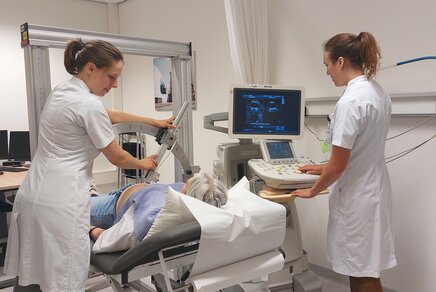Blood-friendly inner lining for artificial hearts
Dina Ibrahim defended her thesis at the Department of Biomedical Engineering on March 5.

In the fight against heart failure, which affects millions of people worldwide, the Hybrid Heart project plays a crucial role. This project aims to develop a fully biohybrid artificial heart, combining regenerative medicine and mechanical heart replacement. An essential aspect of this project is the creation of a protective inner lining for the artificial heart to prevent interactions with blood. This is where PhD student Dina Ibrahim's important research comes in.
The Hybrid Heart project is ambitious and promising. It involves integrating soft robotics to regulate heart contractions and using tissue technology to create a living, blood-friendly inner lining. It is on the latter aspect that Ibrahim's research is focused: making the inner lumen of the Hybrid Heart blood-friendly, where blood comes in contact with synthetic material.
For her dissertation, Dina Ibrahim took on this challenge, taking two approaches. First, the biological approach, which combines cells and biomaterials, and second, the mechano-topographical approach, which mimics the natural characteristics of arteries.
Her research begins by examining the role of blood in creating a blood-friendly inner lining at the interface between blood and biomaterials. This will focus on the specific phenotypes of endothelial cells for different cardiovascular implants. Ibrahim's work has also investigated the origin of these endothelial cells, focusing on the role of immune cells, particularly macrophages (M2c), in the differentiation process.
An important aspect of this research is the use of special biomaterials decorated with bioactive molecules. These molecules attract cells from the bloodstream and convert them into endothelial cells. This not only improves the formation of the endothelial layer, but also reduces the risk of blood clotting.
Printed arterial structures
Another approach Ibrahim explored is 3D printing to create substrates with a wrinkled topography inspired by natural arteries. Although there are challenges related to the behavior of blood cells, she wants to refine the design to improve effectiveness.
Ibrahim's work pushes the boundaries of artificial heart research by mimicking natural endothelial lining and using advanced techniques to create a blood-friendly lining.
Her contribution promises not only safer, but also more effective treatments for heart-related problems in the future, paving the way for the development of artificial hearts that can save lives and improve the quality of life for people around the world.
Title of PhD thesis: “Towards Developing a Hemocompatible Inner Lining at the Blood-Biomaterial Interface of Artificial Hearts”
Supervisors: Carlijn Bouten and Anthal Smits
More on Health



Latest news


![[Translate to English:] [Translate to English:]](https://assets.w3.tue.nl/w/fileadmin/_processed_/e/0/csm_BvOF%202019_1031_BHF%20license%20TUe%20ILI%20copy_8a50884392.jpg)